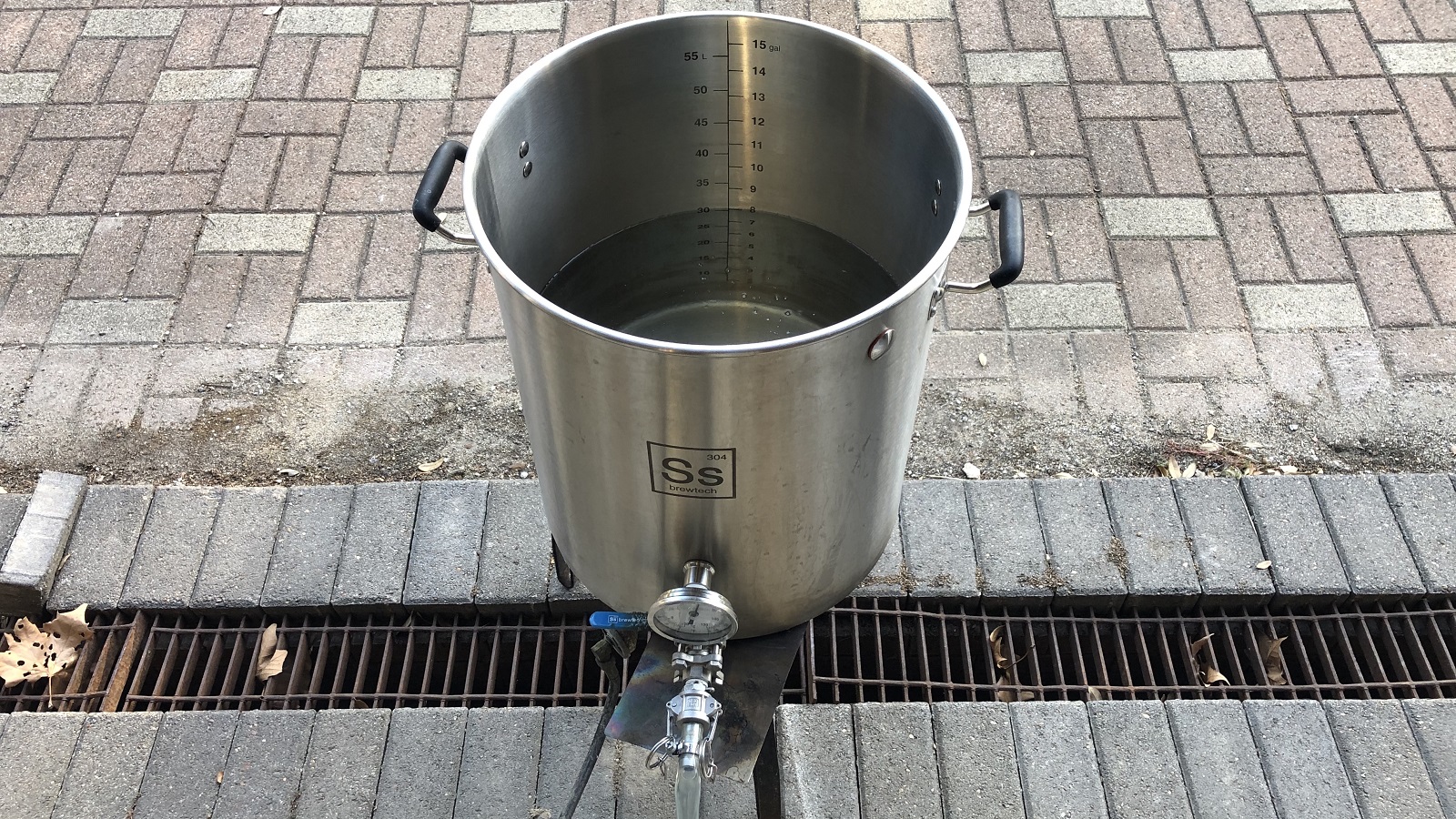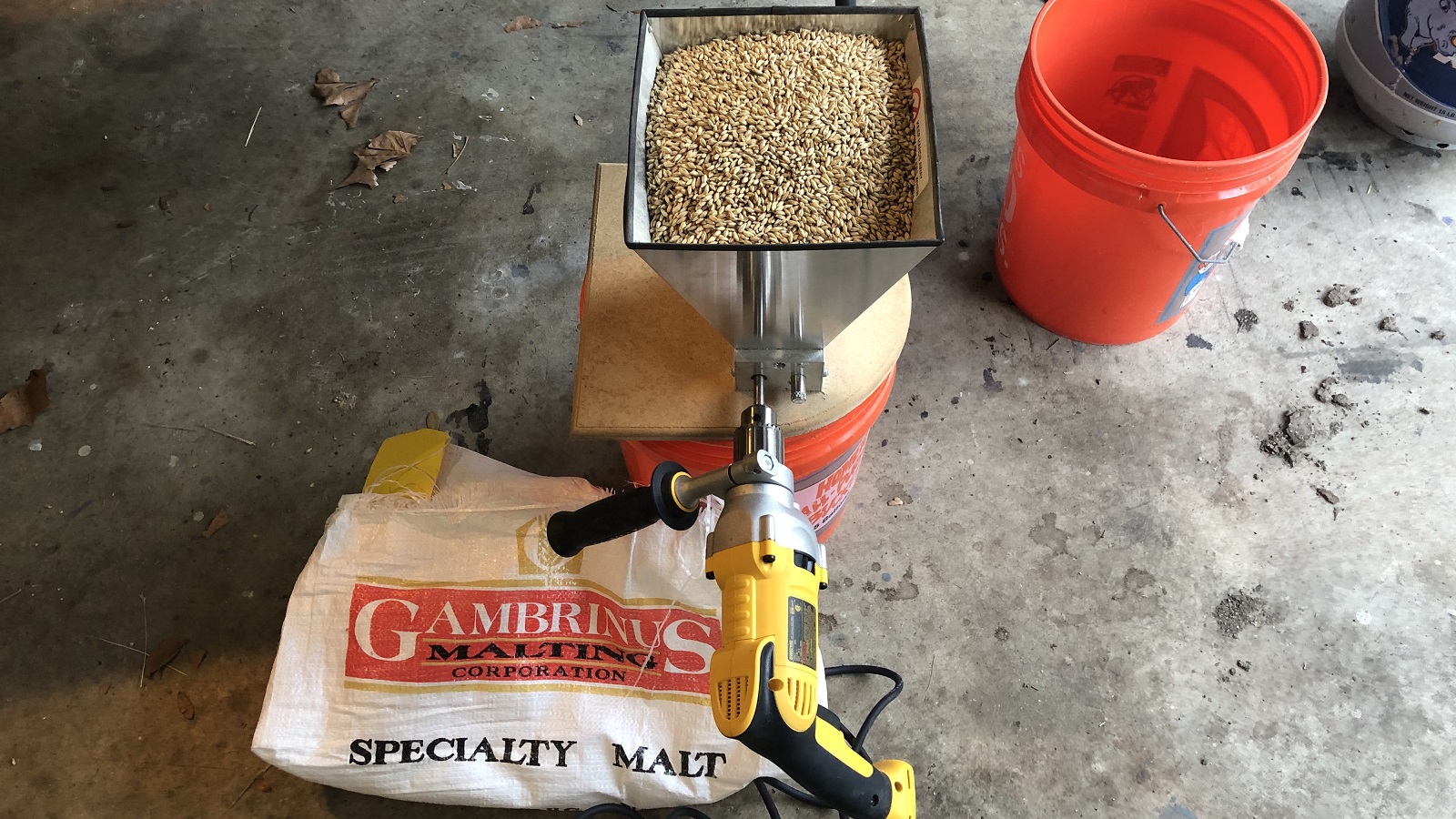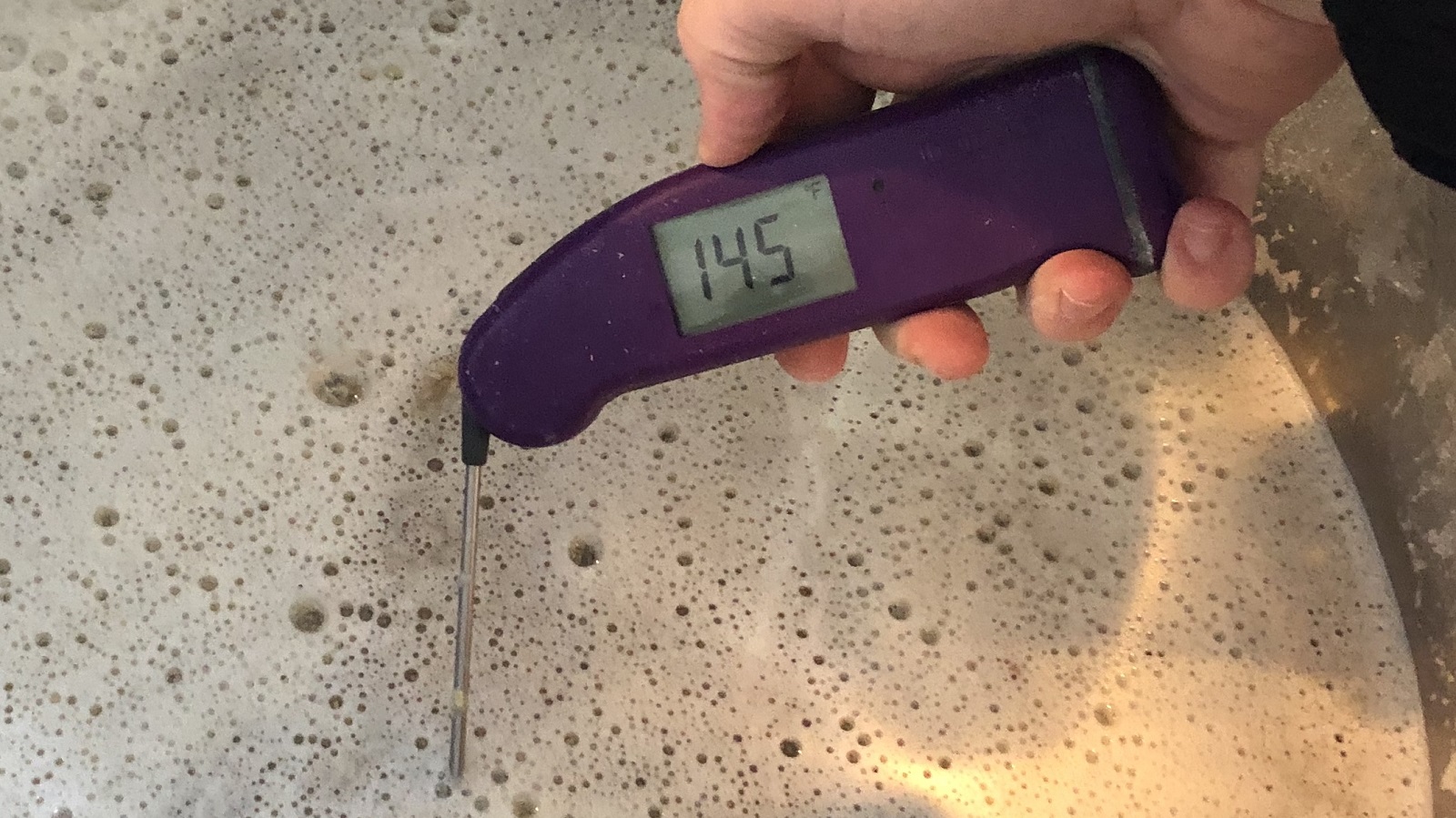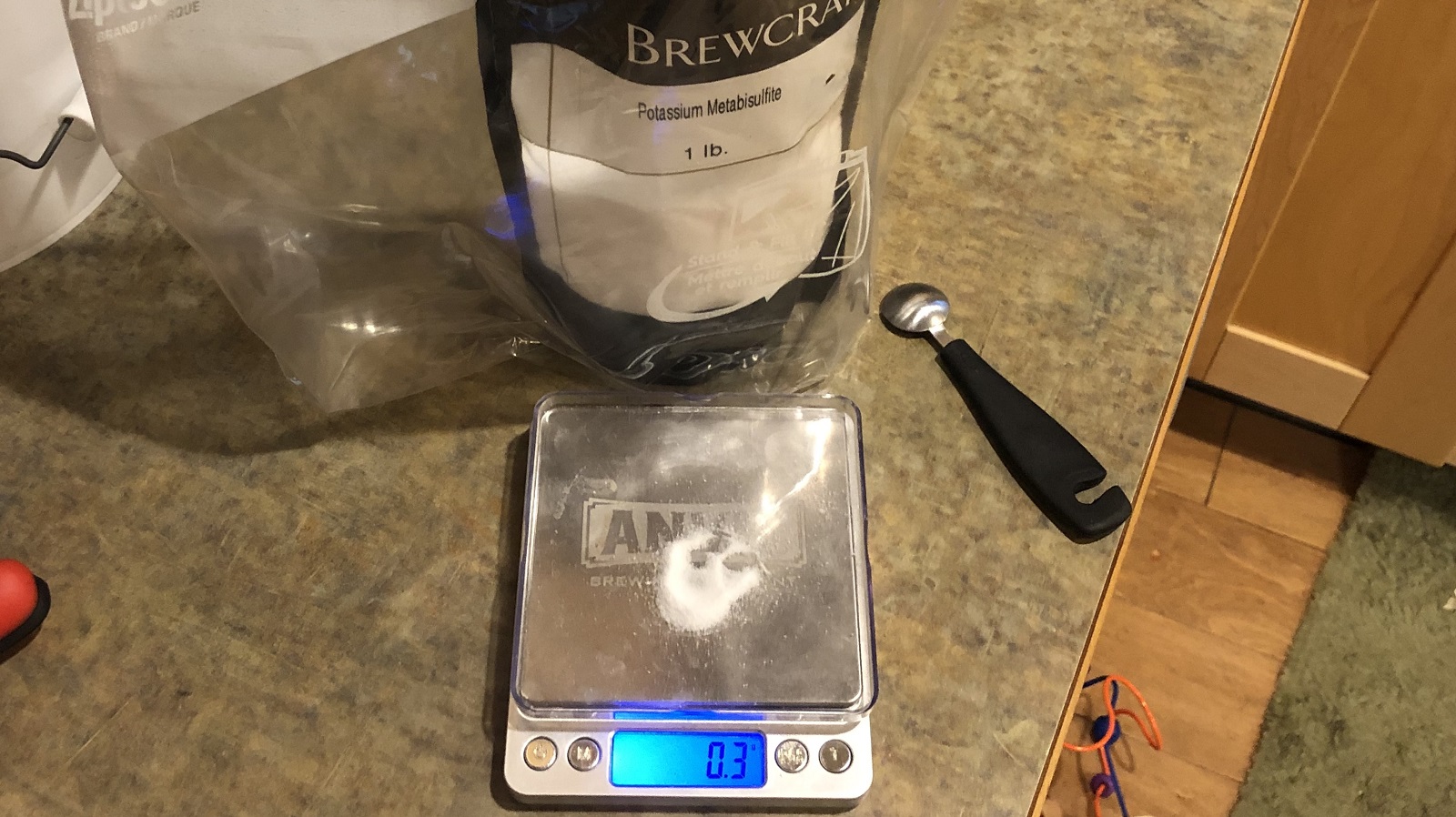Author: Cade Jobe
Oxidation of beer produces stale off-flavors and can lead to shelf-stability issues in finished beer, hence the reason brewers of quality beer go to great lengths to limit cold-side exposure to oxygen. Most methods for reducing this risk involve the use of CO2 to displace oxygen at various points in the process, for example, by using it to push the beer from the fermenter to a keg that’s already been purged of oxygen. However, there are some chemical options as well.
Potassium metabisulfite (PMB) is a crystalline compound that’s commonly used in the wine and cider industries to rid must of wild yeast and bacteria prior to fermentation, as it converts to sulfur dioxide, a disinfectant, once added to the must. Perhaps the most common usage of PMB among beer brewers involves adding a small amount to the brewing liquor to eliminate cholormines, though recently, some have been relying on it as a chemical means of reducing the risk of cold-side oxidation. Like sodium metabisulfite (SMB), once PMB dissolves into beer, a redox reaction occurs wherein sulfite ions bind with oxygen in solution, thus reducing the risk of oxidation. It should be noted both PMB and SMB are sold as Campden tablets.
Given the significant results of our two xBmts on the impact of adding SMB at packaging, I began to wonder if using PMB in the same way would have a similar effect. In response to those prior xBmts, some questioned whether the perceptible difference was caused by the sodium in SMB rather than the redox reaction, so I decided to test it out for myself.
| PURPOSE |
To evaluate the differences between a beer dosed with potassium metabisulfite at packaging and a beer without the chemical.
| METHODS |
My goal being to accentuate any impact of the variable, I went with a simple pale lager for this xBmt.
Safer In Space
Recipe Details
| Batch Size | Boil Time | IBU | SRM | Est. OG | Est. FG | ABV |
|---|---|---|---|---|---|---|
| 5.2 gal | 60 min | 8.2 IBUs | 3.1 SRM | 1.046 | 1.011 | 4.7 % |
| Actuals | 1.046 | 1.005 | 5.4 % | |||
Fermentables
| Name | Amount | % |
|---|---|---|
| Pale Malt (2 Row) US | 7.75 lbs | 79.49 |
| Corn, Flaked | 1.75 lbs | 17.95 |
| Corn Sugar (Dextrose) | 4 oz | 2.56 |
Hops
| Name | Amount | Time | Use | Form | Alpha % |
|---|---|---|---|---|---|
| Tettnang | 14 g | 60 min | Boil | Pellet | 4.5 |
Yeast
| Name | Lab | Attenuation | Temperature |
|---|---|---|---|
| Harvest (L17) | Imperial Yeast | 72% | 50°F - 60°F |
Notes
| Water Profile: Ca 194 | Mg 17 | Na 18 | SO4 389 | Cl 50 |
Download
| Download this recipe's BeerXML file |

I started off my brew day by collecting the proper volume of water for a 10 gallon/38 liter batch, adjusting it to my desired profile, then lighting the flame under the kettle.
While waiting on the water to heat up, I weighed out and milled the grain.
When the water was ready, I stirred in the grains then checked the mash temperature.
During the mash rest, I collected out the kettle hop addition.
When the 60 minute mash was complete, I sparged to collect the target pre-boil volume.
The wort was boiled for 60 minutes then quickly chilled with my IC.
A hydrometer measurement showed I’d hit my target OG.

I racked the wort to a sanitized 14 gallon Brew Bucket and put it in my fermentation chamber controlled to 68°F/20°C before pitching two pouches of Imperial Yeast L17 Harvest.
After 11 days, signs of fermentation activity were absent so I took a hydrometer measurement indicating fermentation was complete.

At this point, I sanitized two kegs and added 0.3 grams of PMB to one of them in order to achieve approximately 10 ppm in the beer.
After purging both kegs with CO2, I proceeded with splitting the batch equally between the kegs.
The filled kegs were placed in my keezer, burst carbonated, then left to lager for 4 weeks before I began serving them to participants.

| RESULTS |
A total of 16 people of varying levels of experience participated in this xBmt. Each participant was served 1 sample of the beer dosed with PMB at packaging and 2 samples of the non-dosed beer in different colored opaque cups then asked to identify the unique sample. While 9 tasters (p<0.05) would have had to accurately identify the unique sample in order to reach statistical significance, only 6 did (p=0.45), indicating participants in this xBmt were unable to reliably distinguish a pale lager dosed with PMB at packaging from one that was not dosed with PMB.
My Impressions: Out of the 4 semi-blind triangle tests I attempted, I happened to guess the odd-beer-out one time. These beers were exactly the same to my senses. Both tasted and smelled like the delicious fizzy yellow lager I intended!
| DISCUSSION |
In addition to methods that use CO2 to displace oxygen at packaging, some rely on chemical additives like potassium metabisulfite (PMB) and sodium metabisulfite (SMB) to reduce the risk of oxidation on the cold-side. Countering the results of a previous xBmt exploring the impact of SMB at packaging, tasters in this xBmt were unable to reliably tell apart a light lager dosed with PMB from one without the compound when the kegs were purged with CO2 prior to being filled.
One impetus for this xBmt was to test whether the sodium in SMB may have been responsible for the perceivable difference in the aforementioned xBmt. The fact tasters generally failed to notice a difference between a PMB dosed beer and a non-dosed version suggests there may be some merit to this claim. It’s important to note that the beers in both this and a prior SMB xBmt were pressure-transferred to CO2 purged kegs, so their exposure to oxygen was already quite limited.
I began packaging with SMB as a direct result of the two previously mentioned xBmt results because I like the additional insurance against cold-side oxidation. While these results seem to suggest PMB may have a different impact than SMB when used at packaging, both undeniably lead to a redox reaction when blended with beer. As such, I look forward to repeating this xBmt in the future with the difference being that neither keg is purged with CO2 before packaging. Until then, I’ll continue using either PMB or SMB when racking my beer to kegs.
If you have any thoughts about this xBmt, please do not hesitate to share in the comments section below!
Support Brülosophy In Style!
All designs are available in various colors and sizes on Amazon!
Follow Brülosophy on:
FACEBOOK | TWITTER | INSTAGRAM
If you enjoy this stuff and feel compelled to support Brulosophy.com, please check out the Support page for details on how you can very easily do so. Thanks!





















39 thoughts on “exBEERiment | Cold-Side Oxidation: Impact Of Dosing American Lager With Potassium Metabisulfite (PMB) At Packaging”
What was your method of purging kegs? Sanitiser fill and then push out with CO2 or pressurising and releasing CO2 multiple times?
I added the PMB to one keg, then pressurized and released CO2 multiple times.
Redo the tasting after 6 months (if you still have those beers in the kegs). The main idea of usage of sulfites is to extend the shelf life. Oxidation does not happen so fast in a beer.
It’s my understanding that oxidation reactions happen fairly quickly, but if I still have the beers in 6 months, I will definitely give this a try.
I can’t point to any peer-reviewed literature here, but unless one has been extremely sloppy in packaging, oxygen damage takes at least ~4 weeks to make itself known. I arrived at this based on 20+ years of homebrewing and brewing commercially for a while. 4 weeks is about when things become noticeable. Tasting a one-month old can of hazy IPA against the same beer in the bright tank is illuminating.
But if your procs are tight and, critically, everything stays cold, it could be many months before any damage becomes noticeable–thus, Andy’s suggestion is a good one. Many homebrewers will have drained the keg prior to 4 weeks, and so they may never notice oxidized homebrew.
Fermenting at 68°?? Is that correct?
Correct. I had other beers fermenting at the same time.
And no off flavors?
Maybe a touch of acetaldehyde, but not off-putting.
how does Harvest compare with 34/70. i like 34/70 but sometimes i think i get a little bit of a raw dough flavor depending on the state of my palate
I haven’t used 34/70 in a long time. It’s nothing against 34/70, it’s just that I’ve used other yeasts for most of my lager brewing. Wish I could be more helpful.
I agree leaving beer for 6 mos. Oxidation is a function of part per million DO, temperature and time. So I am not surpised there is no differnece. I would suggest bottling up enough of each and store half cold and half at room temp for 6 mos. and compare. THe reactions may happen quickly but my guess is you ahve solid kegging process that does not introduce much O2
Yeah I have to agree. I think the kegging procs here are really, really good, but since some O2 ingress is needed to test the variable in the intended way, you’re not really testing what you think you’re testing. Really, all you’re testing is whether 0.3g PMB is flavor-active, not whether it’s protecting against oxidation. I think it would have been useful to deliberately allow some extra O2 ingress in both kegs. On another note, looks like a delicious beer!
Agreed. Considering the title “impact on cold side oxidation” this was poorly designed.
Can you use gelatin and PBM in the same beer or should the beer be cleared and PBM added later?
You use “0.3 grams” and the picture looks to be about the same as a whole Campden tablet. Would that be about correct?
Pretty much, yes. Campden tablets are designed to impart 50ppm sulfite when dosing with one tab per gallon. So for a 5 gallon batch, one tab is 10ppm sulfite. (Check to make sure your campden tabs are the same size as mine, I think there are different ones).
The dosage recommended for wine at bottling time is 50ppm, which is what I used when bottling my last beer as it’s difficult to find solid info on dosage rates for beer. From reading more after the fact, I was worried about production of hydrogen disulfide (rotten egg/rhino fart smell) due to fermentation in the bottle in the presence of sulfite. But I opened a bottle after one week, and there was no off-smell of any kind, so I was really happy about that.
But from now on, if 10ppm does the trick, I will just do that.
What’s was the original intent of this experiment? To determine if the PMB itself was perceptible as a flavor or if it was effective in reducing oxidation?
All three articles seem to be working under the assumption that these redox reactions are happening. But the difference in experiment significance between SMB and PMB leaves some questions. Did they both reduce oxidation equally and the results where different because of the flavor of sodium vs potassium? Or vice versa?
I love your articles. Always fun to read about. In reading “Impact of dosing beer with PMB at packaging” I was left to wonder if the reason that not many people could differentiate between the beers was because there was no oxidation in either beer. So, I was wondering if the xBmt would have been more useful if after you package the two kegs that you dose one keg yet intentionally tried to oxidase both beers and see if the PMB would have prevented the oxidation.
“both undeniably lead to a redox reaction when blended with beer.”
Why do you say that? Did you measure this in some way?
I did not measure it but it’s the chemical reaction that takes place when adding metabisulfite to beer. I do not know how effective the reaction is, but we do know that the reaction takes place.
Thanks!
question about the fermenters. did you add the tri-clamp connection on the lid? is that to add pressure?
Yes, I added it for pressure transfers. SsBrewTech has a guide in their support section with all the parts and instructions. https://ssbrewtech.zendesk.com/hc/en-us/articles/210211086-Can-I-perform-a-pressurized-transfer-with-the-Brew-Bucket-s-flat-lid-
thanks
Fill some bottles of each keg and leave them out of the freezer for 3-4 weeks. Then compare them.
The only reason people think that beer oxidises fast is because of propaganda. Propaganda from the LODO crowd, and scares from people who think that oxygen is like a caterpillar eating away at lettuce.
I am a pretty thrifty homebrewer. I don’t own anything stainless steel, and certainly no CO2 installations. My mash is manually transferred from my mash tun to my filter tun. I bottle by racking into a (food safe) plastic bucket. The only thing I do is avoiding splashing.
Yet my beers are still drinkable and nice after twelve months, also the blonde ones. Of course it tastes different, mostly because tannins tend to drop out (and as a side note, I do not care the least about NEIPA).
It would maybe worthwhile to design a range of experiments over longer time to see what is true and not true about oxidation itself, to remove all these rumours and scares.
Thank you bery much
Try to keep it in a room temperatur for three weeks and then to try…….
I had a beer that was likely to be badly oxidized as a venturi effect occurred during transfer when the seal of the inner piece of my autosiphon started letting air in. I essentially bubbled a lot of air into my beer on transfer. The beer in question was a Sierra Nevada clone.
I added a couple pinches of PMB, as I had read about the ability to reduce O2 and potentially save this beer. I later measured what that would have been and found it was about 0.6g.
Well… the beer developed a strong sulfur dioxide smell. Very strong. I ended up having to bubble CO2 up through the liquid post and then purging the pressure in the keg and repeating until it started to foam out of the pressure release and I had to stop. I then repeated this bubbling of CO2 about 4 more times on different days.
The rotten egg smell finally went away and the beer is not drinkable. One person who has tried it says it doesn’t taste oxidized. I find it tastes good now. Probably is lacking hop aromatics. But it is an enjoyable beer now.
Anyhow, it would be nice to see you try the PMB/SMB experiment on a beer that has obvious O2 pickup from a bad transfer.
I made a wit beer and added 0.3 grms of PMB at kegging just to try this method for the first time. Will never do that again, it was like drinking farts.
Would love to see a flow up experiment, to see how effective PMB is at fighting oxidation. An experiment where two identical beers are brewed using PMB. The only difference being that one beer is transferred to a keg using good practices and the other using poor practices and is exposed to an excess of oxygen.
Like others have stated, I would be interested in an experiment if you used an auto-siphon as the transfer method since that will at the very least allow some O2 to get mixed into the equation. I know this experiment was more or less seeing if tasters could tell if a beer had PMB or not, but your transfer method is much more closed off than a lot of other homebrewers.
I am fairly confident based on scientific literature that 10ppm total SO2 (you added around 8 ppm if you had 5 gallons) is completely negated by the pH of the beer and binding to organic compounds. Also, we must consider how much free SO2 (aka molecular SO2) is available to reduce oxidation from the total SO2 (8ppm) added into solution. Free SO2 is the SO2 (sulfite) that is released AND remains in solution after the potassium or sodium metabisulfite salt dissolves in solution.
First and foremost, the amount of free SO2 released from PMB or SMB is affected by the pH of the liquid and in the case of beer, there is essentially no free SO2 in solution at a normal beer pH around ~4.5 given a dosing of 8 ppm . Given a that pH, it would take 10x the SMB or PMB dosing as used for a pH 3.5 wine due to the log scale of pH units.
https://www.winebusiness.com/tools/?go=winemaking.calc&cid=60
Additionally, not all SMB or PMB is converted to free SO2 (sulfite) in solution because a portion of the SO2 will be come bound to organic matter and therefore cannot react with oxygen on the long-term. Of course, some immediate reduction in O2 will occur right when you pour in the PMB solution, but as indicated above, there is almost zero free SO2 present at beer pH with 8 ppm total SO2 dosed. Also, wine contains fewer organic compounds than beer (proteins, complex carbohydrates, etc) and will have less SO2 becoming bound, so wine should be considered as a poor, overly-conservative model for beer.
https://www.thebeveragepeople.com/how-to/wine/free-so2-in-wine.html
Ultimately, adding 8-10 ppm SO2 does no harm but is insufficient to have substantial short-term oxidation prevention and will not provide any long-term oxidation protection. The prior experiment with 100 ppm SO2 from SMB was a better test of whether SMB can have a perceptible effect on beer.
For readers, note that SMB contains 67.4% SO2 and PMB contains 57.6% SO2, so adjust your additions accordingly.
This is correct right here!
It is a shame that there was no validation of free and total SO2 in the final beers, which can be used alongside pH to calculate molecular SO2.
I’ll just add a link for any one interested on the link between ionic forms of sulfites based on pH. Like Christophe mentioned, it is only molecular SO2 that has antimicrobial and oxygen scavenging properties. You can see that it has a very minimal % of the ionic make up, when the pH is above 3.8 at the following link:
https://www.researchgate.net/figure/Ionisation-forms-of-sulphur-dioxide-depending-on-pH-value-adapted-to-pKa1181-and_fig2_283364221
Further more the amount of free SO2 (FSO2) in wines is significantly higher than what has been added here. Combined with the lower pH of wines, the molecular SO2 is just in a whole different range. For microbial stability in wine, we generally shoot for a molecular pH of >0.8ppm. Using this as a baseline I’ll give an example of use in wine and beer (using the calculator Christophe linked to):
In wine of pH 3.4, aiming for molecular SO2 of 0.8, we need a FSO2 of 32ppm.
In beer of pH 4.4, aiming for molecular SO2 of 0.8, we need a FSO2 of 312ppm.
And this is just FSO2! it doesn’t account for the SO2 that will become bound! Based on this, you would probably need to add around 500ppm of SO2 to achieve that FSO2 level. This is a crazy high level! For reference the legal limit for total SO2 in winemaking in the EU is 250ppm, so we are looking at almost double that here!
At this website:
http://www.cider.org.uk/sulphite.html
I read this about antioxidant properties and pH:
Addition of sulphite after fermentation
The table and chart above is for use of sulphite as an antimicrobial before fermentation. Sometimes it is also used after fermentation has all finished, at racking, storage and bottling. The reason for this is partly antimicrobial but also because it acts as an antioxidant. Or, rather, it mops up the initial products of oxidation such as hydrogen peroxide and aldehydes, preventing them going on to give sherry-like or ‘oxidised’ off-flavours. In those cases it is usual to add a fixed amount of 50 ppm each time (up to the total legal limit of 200 ppm when all additions are summed together) with a view to achieving a residual 30 ppm of free SO2 the next day. This is because the antioxidant properties of sulphur dioxide are not affected by pH.
My question would be, should PMB be added at the point you cold crash, and even before transferring to keg or bottleing? That seem to be the first place we could see cold-side oxidation (?).
I do have the exact same question , would it be ok to push it with my dry hop with hop canon ?
You package in kegs where no secondary fermentation is required. If PMB kills yeast can it be used to package in bottles where some yeast is required for the fermentation.
Like many others, I got a strong sulfur dioxide smell after using the recommended amount of potassium metabisulfite at kegging. I had figured it “couldn’t hurt”, but instead it ruined the beer, and the dry hop aroma is gone after trying to bleed the headspace and get rid of the sulfur. I’m not sure why Brulosophy has like five posts about the same “cold side metabisulfite” experiment, which makes it harder to notice all of the negative experiences people have had, but homebrewers might want to reconsider the advice being given here.